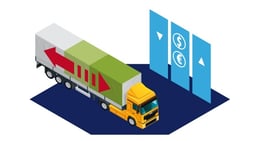How Logistics 4.0 Will Transform the Future
Martin Pahulje - July 01, 2021

We are entering the fourth Industrial Revolution, which introduces us to a tidal wave of technological developments and capabilities, optimizing how we conduct business. This goes hand-in-hand with Industry 4.0, which entails the digitization of the industrial sector. This era has provided us with the digitization of physical elements, completely transforming how they work. This concept signifies that products, factories, machines, and vehicles are all interconnected, working synonymously.
The transformation of our original production systems has led us to digitization, which has entirely changed how supply chains operate. Industry 4.0 has accelerated the rise of new networks, allowing us to easily group information and make systems more interoperable. This then increases data consumption and exchange speed, allowing organizations to make better decisions and produce more quickly and accurately.
The highly advanced technologies geared in Industry 4.0 have redefined the production place by reconstructing centralized and analog workflows through digital processes. Other industries have begun to take note of these innovations, including the logistics division. Growth within this sector is expected to increase exponentially. With the integration of technology into logistics, the industry will become more efficient than ever. Today, we will discuss what the future of Logistics 4.0 may look like and how you can use technology to prepare.
Industry 4.0 and Supply Chain Technology
Industry 4.0 has paved the way for the fourth Industrial Revolution, assimilating information and communication technologies (ICT) to form a solid foundation for innovative industrial technology. These technological advancements are expected to significantly improve operational efficiency, flexibility, and automation – critical factors to achieving resiliency in this economy. These are major benefits, but let's get into specifics. Improvements in technology can lead to:
- The elimination of unnecessary production costs
- Increased throughput
- Reduced cycle times
- Quality maintenance of products
- Improved transportation of goods and services
- Improved overall business performance
With these capabilities, your organization will save valuable time and money, in addition to optimizing your supply chain as a whole.
Components of Logistics 4.0
There are four primary components of logistics 4.0, which together will offer you the benefits we have discussed.
1. Visibility
Driven by technology, the logistics sector will see a significant increase in visibility and transparency from digitization across the supply chain. Visibility is crucial for every supply chain as it allows you to understand operations from a holistic perspective. After all, the supply chain is a chain – each part directly impacts all others, so it is crucial to look at it in its entirety with clarity. Furthermore, visibility encourages businesses to build a smart system, which will make logistics interoperable and transparent. This, in turn, drastically improves efficiency.
Ports worldwide have begun to implement these advanced solutions to equip themselves with real-time tracking and monitoring of shipments. Additionally, managers can view documents from any device to receive accurate and up-to-date information, allowing them to make better business decisions. With visibility comes increased accuracy – which is critical for every supply chain manager.
2. Smart Utilities
The traditional logistics components that we once relied on have been replaced with smarter versions, transforming how shipments are circulated from suppliers to end-users. Technological solutions such as smart containers and pallets have transformed traditional workflows, providing companies will more accurate and reliable data on their products. Classic shipping facilities have started to incorporate fresh prospects on the field to help them collect data faster while performing judgment-related tasks on the gathered analytical information. This automates the decision-making process, saving valuable time while increasing accuracy.
3. IoT Adoption
In the short time that Industry 4.0 has been introduced to the market, several IoT development organizations have moved to develop advanced digital devices to be seamlessly deployed and embedded in warehouse facilities. For these IoT solutions to be successfully included, organizations must be equipped with the proper enhancements to optimize their business operations. Deploying such technologies will enable businesses to enhance utilities and smart containers once connected to the cloud. In addition to evolving supply chain management, IoT adoption will considerably boost profits in gaining granular insights.
4. Industry 4.0 Integration
While Logistics 4.0 runs parallel to the Industry 4.0 paradigm, Logistics 4.0 is capable of collaborating and integrating with Industry 4.0 procedures and systems as well. This integration creates an environment for building a collaborative and synergetic relationship between shippers, manufacturers, and end-users with more efficiency and flexibility than ever before. Furthermore, it offers an elevated level of transparency compared to the classic approaches that most companies still follow. Overall, the 4.0 integration will provide tight security from external threats and advanced storing of essential data while meeting end-user requirements with ease.
How to Prepare for Logistics 4.0
Logistics 4.0 might seem like the solution that companies have been looking for for years, but it does come with some challenges that you should be prepared to face. This development is a lucrative value-added proposition, but reaping the benefits we have discussed can introduce some hurdles. You may face three primary challenges: reducing information silos and Shadow IT, changing the past-oriented planning, and getting rid of old spreadsheet habits. For traditional logistics companies, the most challenging hurdle is typically overcoming the need to use spreadsheets to carry out business operations. To do this, planners will have to abandon their current practices and learn to contribute towards information silos by producing plans in Excel. Additionally, planners will need to counteract the mindset of transparent workflows to achieve success in advanced supply chain management.
It can be challenging to abandon old habits, especially those that still seem to be working. That being said, it is important to realize that with the adoption of new technology, these operations will be drastically simplified and optimized, making it well worth the transition. So, how should you prepare for Logistics 4.0?
Implementing Industry 4.0 in your organization will allow you to develop a better-connected and smarter supply chain process. Smart technologies play a significant role in the implementation process, and they provide several advantages:
- Supply chain transparency
- Automation of repetitive tasks
- Real-time tracking and monitoring
- Improved decision making
- Reduction in inefficiencies
- More accurate forecasting
- Critical thinking
To prepare for Logistics 4.0, you should assess how much of your current infrastructure has gone digital already. Consider if you already have a digital workflow in motion and how you currently get updates on order statuses and proof of delivery. These processes may not seem significant initially, but when digitized as a whole, it is an important step towards forming a robust logistics model. Companies in the supply chain and logistic industry will greatly benefit from the implementation of Logistics 4.0. Not only will the integration of new technology optimize your current business model and operations, but it will provide you with the tools to leap ahead of competitors. Logistics 4.0 is here, and it is time for your organization to get on board.
If you want to learn more get your Guide to Logistics 4.0
In this Guide you will learn:
-
Why a strategic process in transportation planning is a top priority for digitalization
-
What megatrends will increase supply chain volatility
-
How to manage it
LATEST POSTS
- Understand Circular Economy in The Manufacturing Industry
- How Can Industry 4.0 IT Integration Be Achieved Smoothly?
- The Significance of Order Sequencing in Discrete Manufacturing
- How to improve your Supply Chain Management: The Power of Control Towers
- Optimizing Human Resource Scheduling in Manufacturing: A Technological Approach



